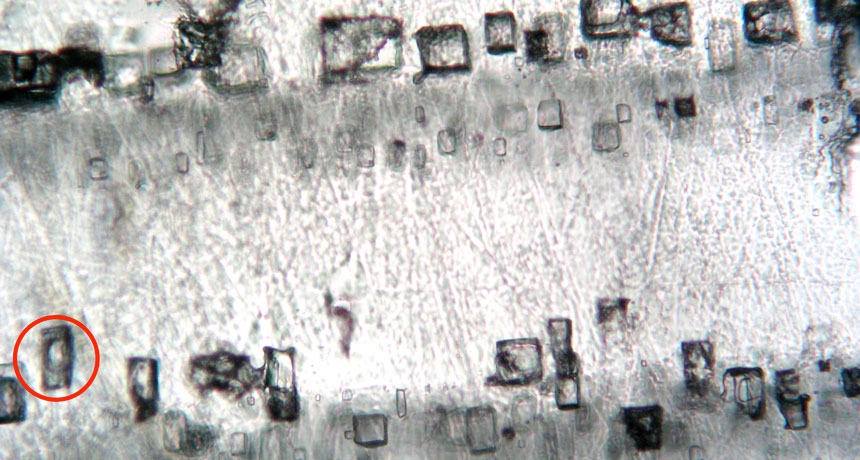Oxygen-rich air emerged super early, new data show
If correct, it occurred before the evolution of animal life

This sample of 815-million-year-old rock salt contains bubbles of ancient air (see the rectangular inclusions, one circled in red). That air indicates that oxygen was already plentiful by the time the first animals later appeared.
CHRIS LECUYER
Whiffs of ancient air are shaking up the history of oxygen — and of life on Earth.
Those tiny puffs of oxygen have been trapped for some 815 million years in rock salt. After carefully crushing the salt, researchers measured the chemical makeup of the air that had been trapped inside it. Oxygen made up 10.9 percent of the air back then, these data showed. This early boost in air’s oxygen occurred around 150 million years before animals showed up in the fossil record. Scientists had thought that oxygen levels would not be that high for another 100 million to 200 million years.
“I think our results will take people by surprise,” says Nigel Blamey. He’s a geochemist at Brock University in St. Catharines, Canada. “We came out of left field, and I think some people are going to embrace it.” Others, he expects, “are going to be very skeptical.” Still, he adds, his team can only go by what their data show.
The researchers report their discovery in the August Geology.
Scientists had previously measured ancient oxygen in Earth’s air. But they went about it in a different way. They had looked for the fingerprints of chemical reactions that need oxygen to occur. That work suggested oxygen levels rose sharply but only some 600 million years ago. The scientists reported that about two years ago,
First direct measurements
Those earlier tests did not measure oxygen directly. And that could have led to uncertainties in the numbers. Blamey’s team instead went to the source — actual air from 815 million years ago.
Back then, in what is now southwest Australia, rock salt formed on the surfaces of evaporating ponds. As the salt grew, microscopic pockets formed. These trapped tiny bits of air. That air remains in the salt to this day.
For their new tests, the researchers crushed pieces of the salt in a vacuum chamber. Each piece, about the size of a match head, released five to 12 micro-puffs of air. Oxygen levels in that air were, on average, more than five times the concentration (2 percent) that earlier studies had predicted. To verify their technique, the researchers also measured oxygen trapped in younger rock salts. These included ones created in modern times. And the technique measured these oxygen levels correctly.
If the new findings are correct, they could add a twist to an ongoing debate. Some scientists had argued, last year, that the evolution of animals had been stalled by a long period when there was too little oxygen in the air.
But the new study has not fully convinced everyone. Outside air may have tainted the new results, says Noah Planavsky. He’s a geochemist at Yale University in New Haven, Conn. Over hundreds of millions of years, gases may have passed through the salt. It this happened, they could have boosted oxygen levels in the air pockets.
Indeed, the oxygen levels just reported are so surprising that they would seem to make outside contamination likely, says Timothy Lyons. He is a geochemist at the University of California, Riverside. A level of 10.9 percent “is really high,” he says. “There is nothing about the shifts you see in life or climate that demands an oxygen jump that high.”
But Nicholas Butterfield has no trouble with the new data. He is a paleontologist at the University of Cambridge in England. Even with plenty of oxygen, he notes, animals still took a long time to evolve after the first emergence of complex life. “The delayed evolutionary appearance of animals,” he has been arguing for a while now, “had nothing to do with [too little] oxygen.”







